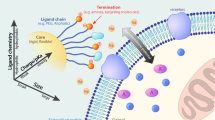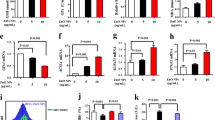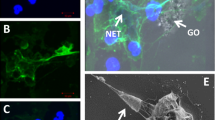Abstract
The increasing use of nanoparticles in medicine has raised concerns over their ability to gain access to privileged sites in the body. Here, we show that cobalt–chromium nanoparticles (29.5 ± 6.3 nm in diameter) can damage human fibroblast cells across an intact cellular barrier without having to cross the barrier. The damage is mediated by a novel mechanism involving transmission of purine nucleotides (such as ATP) and intercellular signalling within the barrier through connexin gap junctions or hemichannels and pannexin channels. The outcome, which includes DNA damage without significant cell death, is different from that observed in cells subjected to direct exposure to nanoparticles. Our results suggest the importance of indirect effects when evaluating the safety of nanoparticles. The potential damage to tissues located behind cellular barriers needs to be considered when using nanoparticles for targeting diseased states.
This is a preview of subscription content, access via your institution
Access options
Subscribe to this journal
Receive 12 print issues and online access
$259.00 per year
only $21.58 per issue
Buy this article
- Purchase on Springer Link
- Instant access to full article PDF
Prices may be subject to local taxes which are calculated during checkout






Similar content being viewed by others
References
Tiede, K. et al. Detection and characterization of engineered nanoparticles in food and the environment. Food Addit. Contam. 25, 795–821 (2008).
Asiyanbola, B. & Soboyejo, W. For the surgeon: an introduction to nanotechnology. J. Surg. Educ. 65, 155–161 (2008).
Park, J. H. et al. Biodegradable luminescent porous silicon nanoparticles for in vivo applications. Nature Mater. 8, 331–336 (2009).
Sajja, H. K. et al. Development of multifunctional nanoparticles for targeted drug delivery and noninvasive imaging of therapeutic effect. Curr. Drug Discov. Technol. 6, 43–51 (2009).
Faraji, A. H. & Wipf, P. Nanoparticles in cellular drug delivery. Bioorg. Med. Chem. 17, 2950–2962 (2009).
Nel, A., Xia, T., Madler, L. & Li, N. Toxic potential of materials at the nanolevel. Science 311, 622–627 (2006).
Nanoscience and Nanotechnologies: Opportunities and Uncertainties (The Royal Society, London, 2004); available at <www.royalsoc.ac.uk/policy>.
Bosman, S. J. et al. Development of mammalian embryos exposed to mixed-size nanoparticles. Clin. Exp. Obstet. Gynecol. 32, 222–224 (2005).
Stone, V., Johnston, H. & Clift, M. J. Air pollution, ultrafine and nanoparticle toxicology: cellular and molecular interactions. IEEE Trans. Nanobiosci. 6, 331–340 (2007).
Seaton, A. & Donaldson, K. Nanoscience, nanotoxicology and the need to think small. Lancet 365, 923–924 (2005).
Stern, S. T. & McNeil, S. E. Nanotechnology safety concerns revisited. Toxicol. Sci. 101, 4–21 (2008).
Myllynen. P. K. et al. Kinetics of gold nanoparticles in the human placenta. Reprod. Toxicol. 26, 130–137 (2008).
Singh, S. & Nalwa, H. S. Nanotechnology and health safety—toxicity and risk assessments of nanostructured materials on human health. J. Nanosci. Nanotechnol. 7, 3048–3070 (2007).
Keegan, G. M., Learmonth, I. D. & Case, C. P. Orthopaedic metals and their potential toxicity in the arthroplasty patient: a review of current knowledge and future strategies. J. Bone Joint Surg. Br. 89, 567–573 (2007).
Case, C. P. et al. Widespread dissemination of metal debris from implants. J. Bone Joint Surg. Br. 76, 701–712 (1994).
Papageorgiou, I. et al The effect of nano- and micron-sized particles of cobalt–chromium alloy on human fibroblasts in vitro. Biomaterials 28, 2946–2958 (2007).
Drewlo, S., Baczyk, D., Dunk, C. & Kingdom J. Fusion assays and models for the trophoblast. Methods Mol. Biol. 475, 363–382 (2008).
Liu, F., Soares, M. J. & Audus, K. L. Permeability properties of monolayers of the human trophoblast cell line BeWo. Am. J. Physiol. 273, C1596–1604 (1997).
Parry, S. & Zhang, J. Multidrug resistance proteins affect drug transmission across the placenta. Am. J. Obstet. Gynecol. 196, 476.e1–6 (2007).
Bhat, P. & Anderson, D. A. Hepatitis B virus translocates across a trophoblastic barrier. J. Virol. 81, 7200–7207 (2007).
AshaRani, P. V., Low Kah Mun, G., Hande, M. P. & Valiyaveettil, S. Cytotoxicity and genotoxicity of silver nanoparticles in human cells. ACS Nano. 24, 279–290 (2009).
Derfus, A. M., Chan, W. C. W. & Bhatia, S. N. Intracellular delivery of quantum dots for live cell labeling and organelle tracking. Adv. Mater. 16, 961–966 (2004).
Shestopalov, V. I. & Panchin, Y. Pannexins and gap junction protein diversity. Cell Mol. Life Sci. 65, 376–394 (2008).
Evans, W. H., De Vuyst, E. & Leybaert, L. The gap junction cellular internet: connexin hemichannels enter the signalling limelight. Biochem. J. 397, 1–14 (2006).
Stahlut, M., Petersen, J. S., Hennan, J. K. & Ramirez, M. T. The antiarrhythmic peptide rotigaptide (ZP123) increases connexin 43 protein expression in neonatal rat ventricular cardiomyocytes. Cell Commun. Adhes. 14, 239–249 (2006).
Clarke, C., Williams, O. J., Martin, P. E. & Evans, W. H. ATP release by cardiac myocytes in a simulated ischaemia model. Inhibition by a connexin mimetic peptide and enhancement by an antiarrhythmic peptide. Eur. J. Pharmacol. 605, 9–14 (2009).
Pelegrin, P. & Surprenant, A. Pannexin-1 mediates large pore formation and interleukin-1beta release by the ATP-gated P2X7 receptor. EMBO J. 25, 5071–5082 (2006).
Michel, A. D. et al. Direct labelling of the human P2X7 receptor and identification of positive and negative cooperativity of binding. Br. J. Pharmacol. 151, 103–114 (2007).
Schwiebert, E. M. & Zsembery, A. Extracellular ATP as a signalling molecule for epithelial cells. Biochim. Biophys. Acta 1615, 7–32 (2003).
Liu, J. et al. Calcineurin is a common target of cyclophilin–cyclosporin A and FKBP–FK506 complexes. Cell 66, 807–815 (1991).
Crabtree, G. R. Calcium, calcineurin and the control of transcription. J. Biol. Chem. 276, 2313–2316 (2001).
Surprenant, A. & North, R. A. Signaling at purinergic P2X receptors. Annu. Rev. Physiol. 71, 333–359 (2008).
Lai, C. P. et al. Tumor-suppressive effects of pannexin 1 in C6 glioma cells. Cancer Res. 67, 1545–1554 (2007).
Papageorgiou, I. et al. Genotoxic effects of particles of surgical cobalt chrome alloy on human cells of different age in vitro. Mutat. Res. 619, 45–58 (2007).
Schins, R. P. & Knaapen, A. M. Genotoxicity of poorly soluble particles. Inhal. Toxicol. 19, 189–198 (2007).
Xia, T., Kovochich, M., Liong, M., Zink, J. I. & Nel, A. E. Cationic polystyrene nanosphere toxicity depends on cell-specific endocytic and mitochondrial injury pathways. ACS Nano. 2, 85–96 (2008).
Baumann, M. U., Zamudio, S. & Illsley, N. P. Hypoxic upregulation of glucose transporters in BeWo choriocarcinoma cells is mediated by hypoxia-inducible factor-1. Am. J. Physiol. Cell Physiol. 293, C477–485 (2007).
Bao, L., Locovei, S. & Dahl, G. Pannexin membrane channels are mechanosensitive conduits for ATP. FEBS Lett. 572, 65–68 (2004).
Mothersill, C. & Seymour, C. B. Radiation-induced bystander effects and the DNA paradigm: an ‘out of field’ perspective. Mutat. Res. 597, 5–10 (2006).
Ballarini, F. et al. Modelling radiation-induced bystander effect and cellular communication. Radiat. Prot. Dosimetry 122, 244–251 (2006).
Huppertz, B. The anatomy of the normal placenta. J. Clin. Pathol. 61, 1296–1302 (2008).
Kibschull, M., Gellhaus, A. & Winterhager, E. Analogous and unique functions of connexins in mouse and human placental development. Placenta 29, 848–854 (2008).
Malassiné, A. & Cronier, L. Involvement of gap junctions in placental functions and development. Biochim. Biophys. Acta 1719, 117–124 (2005).
Aplin, J. D., Jones, C. J. & Harris, L. K. Adhesion molecules in human trophoblast—a review. 1. Villous trophoblast. Placenta 30, 293–298 (2009).
Warrell, D. A., Cox, T. M., Firth, J. D. & Benz, E. J. Jr Oxford Textbook of Medicine (Oxford Univ. Press, 2009).
Wells, P. G. et al. Molecular and biochemical mechanisms in teratogenesis involving reactive oxygen species. Toxicol. Appl. Pharmacol. 207, 354–366 (2005).
McArdle, H. J., Anderson, H. S., Jones, H. & Gambling, L. Copper and iron transport across the placenta: regulation and interactions. J. Neuroendocrinol. 20, 427–431 (2008).
Sagot, P. et al. Prenatal diagnosis of tetraploidy. Fetal Diagn. Ther. 8, 182–186 (1993).
Doherty, A. T. et al. Increased chromosome translocations and aneuploidy in peripherable blood lymphocytes of patients having revision arthroplasty of the hip. J. Bone Joint Surg. Br. 83, 1075–1081 (2001).
Hardin, J. W. & Hilbe, J. M. Generalized Linear Models and Extensions 2nd edn (Stata Press, 2007).
Acknowledgements
Advice and discussion was kindly provided by A. Poole and A. Halestrap (University of Bristol). Support from the Research Foundation Non-medical Committee of the charitable trusts for the University Hospitals Bristol is acknowledged.
Author information
Authors and Affiliations
Contributions
C.P.C., G.B., A.S., M.S. and L.C. conceived and designed the experiments. G.B., A.S., L.C., B.F., G.L., S.D., L.H., P.V., J.L. and K.H. performed the experiments. C.P.C., G.B., A.S., L.C., M.S., W.H.E., A.-M.S., G.L., S.D., L.H., P.V., J.L. and K.H. analysed the data. M.S., W.H.E., A.M.S. and E.I. contributed materials and analysis tools. C.P.C., G.B., A.S., W.H.E. and S.M. co-wrote the paper.
Corresponding author
Supplementary information
Supplementary information
Supplementary information (PDF 1259 kb)
Rights and permissions
About this article
Cite this article
Bhabra, G., Sood, A., Fisher, B. et al. Nanoparticles can cause DNA damage across a cellular barrier. Nature Nanotech 4, 876–883 (2009). https://doi.org/10.1038/nnano.2009.313
Received:
Accepted:
Published:
Issue Date:
DOI: https://doi.org/10.1038/nnano.2009.313
This article is cited by
-
Microbiota in a long survival discourse with the human host
Archives of Microbiology (2023)
-
Multiplexed targeting of miRNA-210 in stem cell-derived extracellular vesicles promotes selective regeneration in ischemic hearts
Experimental & Molecular Medicine (2021)
-
Apprehending Ulcerative Colitis Management With Springing Up Therapeutic Approaches: Can Nanotechnology Play a Nascent Role?
Current Pathobiology Reports (2021)
-
The in vitro toxicity evaluation of halloysite nanotubes (HNTs) in human lung cells
Toxicological Research (2021)
-
Implant-derived CoCrMo alloy nanoparticle disrupts DNA replication dynamics in neuronal cells
Cell Biology and Toxicology (2021)



